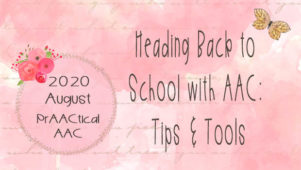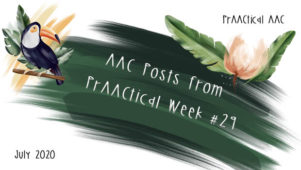How I Do It: Working with Multiple Symbol Sets

Amanda Samperi is back with the second post in her series about getting ready to return to school-based AAC services. Amanda is an AAC SLP who has worked in a variety of service delivery settings and runs the blog, AAC is Where It’s AT. Currently, she provides push-in language therapy to children with complex communication needs at a substantially-separate center school in Florida. She also conducts AAC/AT evaluations, provides year-round parent trainings, and assists the SLP team in instructing teachers/staff about communication supports and strategies In today’s post, she addresses a situation faced by many AAC teams: Serving children who use a variety of different AAC symbols and systems.
If you missed Amanda’s initial post on back-to-school AAC, you can catch up on that here.
:::::::::::::::::::::::::::::::::::::::::::::::::::::::::::::::::::::::::::::::::::::::::
How I Do It: Working with Multiple Symbol Sets
It’s the beginning of the year – desks are in their spots, students’ names are on the outside of the door, the 37th draft of your schedule has been printed, and your classroom is covered in Picture Communication (PCS) symbols from last year. You’re all ready to go!
But… life is never that simple.
You meet your newest student who has a whole different set of picture symbols – Symbolstix – on his device.
How is that even possible? Why are there different symbols? You spent so much time, energy, and money putting those PCS symbols all over the place last year. Do you take it all down and start from scratch? Do you add all of the symbols to everything so you’re prepared? Do you hide in the corner and cry??
Okay, don’t resort to crying just yet! Let’s think about this.
What is the goal?
Think back to the very basics of AAC. What is the goal?
At the end of the day, we hope that users of AAC are effective and efficient communicators. In order to achieve that, we want people to be able to say what they want, when they want it. This is also known as SNUG – Spontaneous Novel Utterance Generation (Hill). This is typically achieved by using some combination of alpha/numeric typing and communication symbols, as a symbolic communication system cannot be preprogrammed to contain every fringe word in the universe. Therefore, it is vital that we are teaching how to use both alpha/numeric AND communication symbols.
What does this mean for schools?
Schools are intuitively designed for consistent exposure to literacy skills, including letters and numbers. However, we have to think critically to design classroom environments for symbolic communication exposure as well. We also know that, in order to speak AAC, we must teach AAC. If we expect someone to use AAC, we have to use AAC. That’s the foundation for aided language input and modeling (Binger & Light, 2007; Drager et. al., 2006, 2010; Goossens’, Crain, & Elder, 1992; Harris & Reichle, 2004).
What does this look like?
Be thoughtful of how to spend your time
No matter how shiny your superhero cape is, you are limited to 24 hours in a day. Spend that time thoughtfully!
It likely isn’t worth your time to take each of your favorite books, identify targeted core vocabulary, finding the symbols on the computer, printing the symbols in the appropriate size, cutting the symbols out, and gluing them into the book. This might be okay to do once a month, with the help of support staff, if all of your students are using the same symbols. However, once multiple symbol sets get involved, this becomes too complicated and time-consuming.
(For more information on when you should and shouldn’t add symbols to books, check out this presentation from AAC in the Cloud in 2017).
Sometimes it’s easy to get lost in projects and forget what the end goal is – consistent and easy exposure to symbolic language for modeling purposes.
Core Word Wall – Making it easy to model for everyone
It’s not easy to add a symbol for each symbol set in every nook and cranny of a classroom. However, it is possible to do a bit of upfront work to make modeling for everyone a bit easier!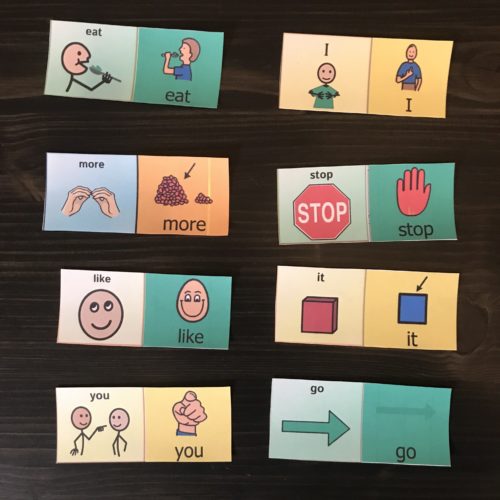
Try printing out 1 copy of your core board with both (or all) of the symbol sets used by the students in your classroom. As you can see in the picture above, I placed the SymbolStix symbol on the left, and the PCS symbol on the right, for motor planning purposes. You can use editing software (such as SymbolStix PRIME, Chat Editor {Free}, Communicator 5, Boardmaker Online, etc.) to capture images of the symbols, with or without background color. Then, you can use one of many software like PowerPoint, Word, or even Google Docs to place the symbols side-by-side and print them. Once laminated, these symbols can be used to model using 2 symbol sets at one time!
For more information on classroom core boards, please see the following resources:
- Carla Butorac from Behavior Communicates
- AAC in the High School Classroom: Where Core Vocabulary Meets Life Skills
- Jenna Rayburn Kirk from Speech Room News
Bring it with you
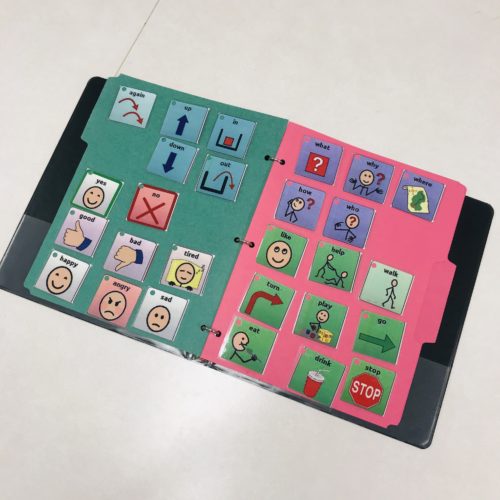
A teacher I worked with years ago came up with an idea to bring a students’ core vocabulary symbols with her everywhere around the school. We took a binder and filled it with file folders, which are nice and sturdy. From there, we lined the file folders with Velcro strips and used them to store low-tech core vocabulary symbols. This became a mobile modeling tool, as well as a backup in case her high-tech system failed! It’s also cheap to make and efficient to use. Win-win!
Model on the student’s device
Students need to see us using their devices too. If you’re not invested in using it, why should they be?
While this isn’t a preferred method for every student (there have been several students who are protective of their devices), this often shows the student how they can use their device in the moment, often for powerful and motivating consequences (like watching Mickey Mouse!).
Talk it out
One of the reasons core vocabulary symbols are so difficult to learn is because they are very challenging to depict. Because of that, symbol sets can have different images to symbolize the same words. Rather than ignore these differences, why not talk through them?
Try carving out 5 minutes each day during Morning Meeting to talk about the Core Word of the Week.
- I Spy Core – Find the core symbol hidden around the classroom
- Read a book with the core word
- Sing a song with the core word
- Talk about it – How do both of the symbols represent the core word? If you had to draw that symbol, how would you draw it?
Overall, it’s important to remember the best way to spend your time, energy, and money. You’ll get a lot of bang for your buck with core symbols. Set them up in your classroom wisely.
Want to learn more about how I get back-to-school ready? Check out this article from last week!
References
Binger, C., & Light, J. (2007). The effect of aided AAC modeling on the expression of multi-symbol messages by preschoolers who use AAC. Augmentative and Alternative Communication, 23, 30–43.
Drager, K. D. R., Light, J., & McNaughton, D. (2010). Effects of AAC interventions on communication and language for young children with complex communication needs. Journal of Pediatric Rehabilitation Medicine: An Interdisciplinary Approach, 3, 303–310.
Drager, K. D. R., Postal, V. J., Carroulus, L., Castellano, M., Gagliano, C., & Glynn, J. (2006). The effect of aided language modeling on symbol comprehension and production in 2 preschoolers with autism. American Journal of Speech-Language Pathology, 15, 112–125.
Goossens’, C., Crain, S. S., & Elder, P. (1992). Engineering the preschool environment for interactive symbolic communication 18 months to 5 years developmentally. Birmingham, AL: Southeast Augmentative Communication Publications.
Harris, M., & Reichle, J. (2004). The impact of aided language stimulation on symbol comprehension and production in children with moderate cognitive disabilities. American Journal of Speech-Language Pathology, 13, 155–167.
Hill, K. Augmentative and Alternative Communication Decisions. Retrieved from https://www.asha.org/public/speech/disorders/CommunicationDecisions/
:::::::::::::::::::::::::::::::::::::::::::::::::::::::::::::::::::::::::::::::::::::::::::::::::::
If you’d like to read more about the topic of serving AAC learners through core vocabulary instruction, these past posts may be of interest.
- Core Boards in the Classroom: 3 Ways to Individualize to Meet Student Needs
- PrAACtical Teaching in an ASD Classroom: Bigger is Better with Core Vocabulary
- PrAACtical Teaching in the ASD Classroom: Little Tips for Big Core
- How We Do It: Incorporating Core Vocabulary Throughout the School Day
- AACtually Doing It: Core in the Classroom
Filed under: Featured Posts, PrAACtical Thinking
Tagged With: back to school, classroom, implementation ideas, symbols
This post was written by Carole Zangari

